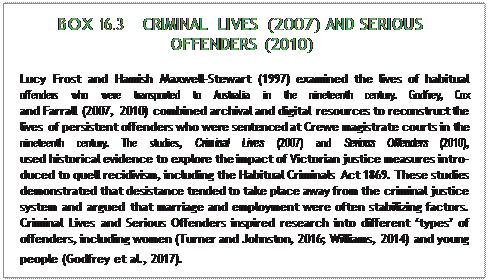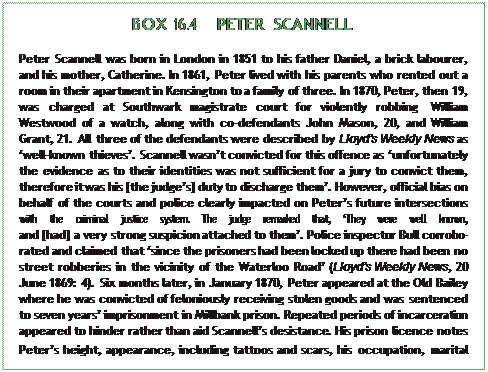 |
History, digitization and biography
|
|
|
|
History, digitization and biography
Over the past decade, historians of crime have adopted life-course methodology to reconstruct the lives of offenders whose lives would otherwise be forgotten or ignored: ‘This approach is holistic and takes in all of the features of a person’s life, not just their criminal careers, and does so from the time they were born till the time they died’ (Godfrey, 2016: 145). As Godfrey (2016: 146) contends, the life-course approach, with its focus on the personal as well as legal experiences of offenders, ‘forces historians to see periods of offending as unusual and secondary in the lives of most offenders’. He continues: ‘It emphasizes the humanity of the subject under study – the criminal – and encourages a sympathetic and empathetic response’ (Godfrey, 2016: 146. See also P. Cox, H. Shaw and B. Godfrey, Chapter 8).
Contemporarily, the digitization of historical data sets, including the criminal reg- isters, census, and birth, marriage and death records, has enabled researchers to piece together the social, personal and legal worlds of Victorian offenders (see Box 16. 3 for further details). Using this data, it is possible to reconstruct a criminal life from the cradle to the grave and examine a chronological series of events, including mar- riage, family formation, divorce, military service, their employment and residential patterns, alongside records of their offending and punishments by searching for them through genealogical sites (including Ancestry and Findmypast, amongst others). These sources facilitate an understanding of how personal circumstances, legal and socio-economic policies and events impacted on the lives of individuals. And, when we look at a large sample of individuals via such data, it is possible to examine pat- terns of recidivism and desistance. In doing so, the collation and synthesis of multiple individual lives encourage historians to ask contemporary ‘what works? ’ questions of criminal justice practices in the past and the present. This has been made more
possible through the Digital Panopticon project which synthesizes criminal, legal and social records from London and Australia.
 |
THE DIGITAL PANOPTICON: FROM ‘STANLEY’TO
‘ SCANNELL ’
The Digital Panopticon project investigates the effectiveness of punishments, includ- ing imprisonment and transportation, in reducing or exacerbating offending by comparing the life experiences of 90, 000 criminals sentenced at the Old Bailey between 1790 and 1925. This resource represents the next stage in the ‘industrial production’ of criminal lives. It is, as Godfrey (2016: 150) argues, ‘biographical research on an industrial scale’. The Digital Panopticon is a public, searchable web- site, aimed at a wide range of users. It weaves together hitherto disparate fragments of the lives of those convicted of criminal offences and follows their journeys from the cradle to the grave. This resource allows users to search for individuals across multiple data sets, examine and compare the lives of offenders sentenced to impris- onment and transportation, and interrogate and develop new research questions for understanding and exploiting vast and complex bodies of social, personal and crimi- nal data. As Godfrey (2016: 150) argues, ‘That this data “recovers” and pieces together the lives of the most dispossessed and criminalised in society is remarkable’, and, due to data restrictions on contemporary crime data, ‘We will know more about eighteenth- and nineteenth-century prisoners serving time today’.
|
|
|
Life through a (biographical) lens
The Digital Panopticon resource usefully does the work of the historian or crimi- nologist. Previously, researchers utilizing historic data for life-course studies had to reconstruct offenders’ lives by trawling through archives and online sites such as Ancestry, Findmypast, and birth, marriage and death records, for example. But the Digital Panopticon has synthesized social, criminal and legal data sets from Hanoverian and Victorian London, and Australia. The site then allows students and researchers to put an individual criminal life ‘under the microscope’, or researchers can use the site as a ‘macroscope’ and explore thousands of criminal lives.
Having extolled the uses of historical digital data to understand the criminal lives of ‘others’, we now put this into practice by drawing on a case study of a Victorian offender: Peter Scannell. This particular offender features on the Digital Panopticon website, and we employ his case here to illustrate the potential of using biography as a ‘lens’ through which to examine the complex dynamics of crime and punishment when experienced as part of the life course (see Box 16. 4). What we encourage you to consider when reading through this example is not only what is included within the outlined biography, but also what is missing or unseen.
 |

Biographies like Peter’s hold significant value when attempting to examine pat- terns of offending and desistance. They also pre-date the famous Chicagoan example of the ‘jack roller’, Stanley, by a considerable historical margin. At an individual level, these biographies emphasize the importance of employment, residential stability and marriage in encouraging desistance from crime. Conversely, these narratives also reveal the trigger factors which encouraged the onset and persistence of offending, such as the poverty experienced by men in casual labouring occupations which encouraged a variety of Peter’s life experiences as an offender, including: his onset into theft; the policing of working-class ‘rough’ masculinities; the regulation of street life through his robbery prosecution; as well as the impact of institutionalization through his repeated spells of imprisonment. When biographies like Peter’s are con- stituted as part of a much larger sample, such as those linked together through the Digital Panopticon, it will be possible to examine patterns of recidivism and desist- ance on a larger, and potentially global, scale.
When placed within their social, political, legal, economic and cultural contexts,
|
|
|
the narrative of biographies can therefore be a ‘lens’ through which to examine broader structural factors which promote desistance and recidivism. Indeed:
The lives of the poor can then be contextualized; their ‘moral failings’ and hereditary weaknesses’ revealed as prejudicial labels for people with low financial and social capital who were unable to respond to the inequalities of the prevailing socio-economic system. (Godfrey, 2016: 143)
Historians of crime have long sought to recover the lives of the forgotten as part of the drive to reconstruct ‘history from below’. Initially inspired by E. P. Thompson’s survey of the working classes, crime historians have sought to explore the social, spatial and legal worlds of offenders in the eighteenth and nineteenth centuries, whilst not condemning their lives to ‘the condescension of posterity’ (Thompson, 1963: 12). As Godfrey (2016: 149) concludes:
The analysis of the whole life-course of individuals and the representation of those lives in ways which humanize the poor and disadvantaged and make visible the challenges which shaped their lives, is, in essence, an attempt to retrospectively ‘rescue’ lives.
With the historical and contemporary contexts of biographical methods within criminology now outlined, we now turn our attention to ways in which these approaches to ‘doing criminological research’ can be considered critically.
|
|
|


